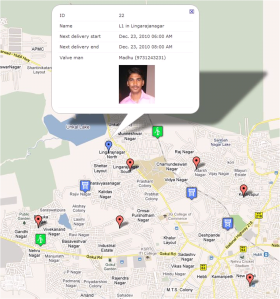One year ago, when we were just a team of graduate students with a big idea, our teammate Thejo Kote came to Hubli and demoed a web-based dashboard to the Executive Engineer and Commissioner in Hubli. The dashboard uses google maps to show the status of valves and other system components in real time, using information provided via voice or SMS.
Building that dashboard marked a turning point in our company — it was our 1st real “pivot,” as we moved decisively away from crowd-sourcing information from residents, which wasn’t working. It was also the way to make progress with the utility, partner with them, and ultimately, win competitions that would enable us to get NextDrop off the ground.
Implementing that dashboard is part of the larger vision of how NextDrop can ultimately revolutionize information flow in water utilities, but based on what we’ve learned so far, it’s not clear that it’s the low-hanging fruit in terms of how to make the lives of engineers easier today.
In Hubli, utility engineers have the computers and internet access you need to follow the days’ supply cycle through a live dashboard, but they’re not quite there yet in terms of integrating that technology into their day-to-day routines.
But there’s a different technology they are using — everyone in the utility has a mobile phone, and they are incredibly adept at handling calls from 100s of people each day, as they do things as varied as managing valvemen, dealing with customer complaints, coordinating tanker deliveries, overseeing pipe damage repairs, and interfacing with other engineers.
Last week, Adity and I went to the field with Mr. Santosh, one of the two Section Officers in Hubli’s North Zone. While he was showing us the NR Betta Tank, we got to see first hand the volume of calls he deals with.
Like all the engineers in the utility, Mr. Santosh’s number is public, so even customers in his area can call him directly with complaints. Here are some notes from my interview with him:
How many calls do you get and who calls you?
- 30 to 40 calls per day from NR Betta Tank, the major reservoir tank he is responsible for, where he checks on the reservoir level and chlorine levels.
- 15 to 20 calls per day from his valvemen updating him on where they provided water.
- 20 calls per day from the public inquiring about new connections.
- 40 calls per day about tanker tuck deliveries.
While we’re still learning a lot about the utility, we think the products that will make the lives of utility engineers easier today will have the following qualities:
- Reduce the volume of calls the engineers get.
- Provide them information through the mobile phone, the medium they already use.
- Generate clear electronic records that can be studied over time.
With this in mind, we’re launching a daily SMS that will inform utility engineers whether water was delivered to all the areas they’re responsible for, and notify them of any exceptions to the set schedule. Beyond that, we’re looking at opportunities to help engineers track the status of pipe damage repairs and tanker deliveries.
More news on new utility products soon to follow!


